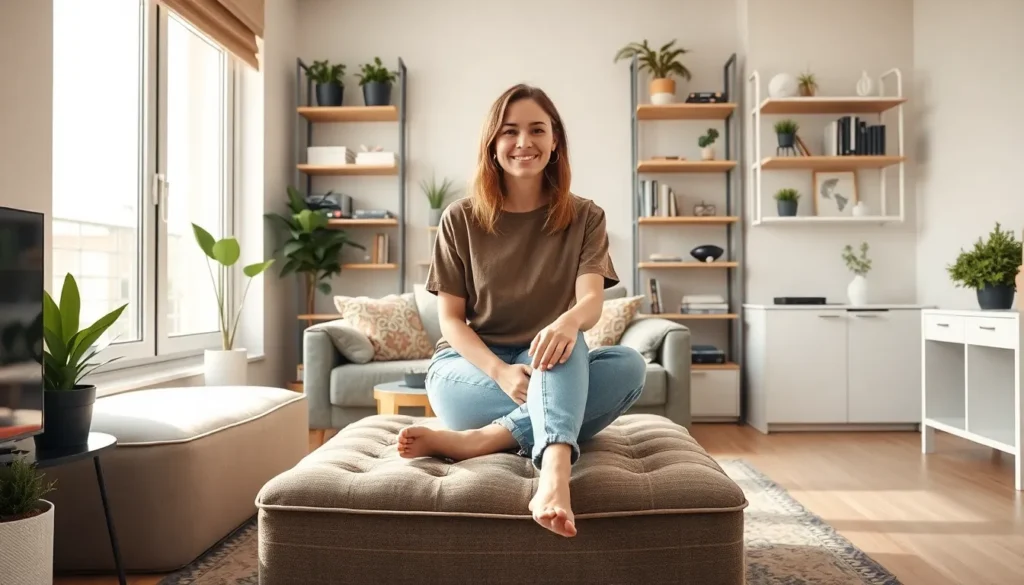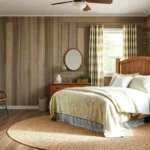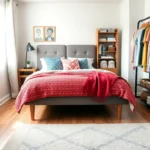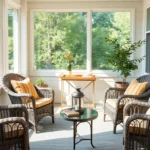Living in a tiny apartment doesn’t mean sacrificing style or functionality. We’ve all faced the challenge of making the most out of limited square footage while creating a space that feels like home. The key lies in smart design choices that maximize every inch without overwhelming your living area.
Small spaces actually offer unique opportunities for creativity and innovation. We can transform cramped quarters into efficient and beautiful homes through strategic furniture placement clever storage answers and thoughtful design elements. The right approach turns limitations into advantages making your tiny apartment feel surprisingly spacious.
Whether you’re downsizing by choice or necessity we’ll show you how to create a comfortable functional living space that reflects your personality. From multi-purpose furniture to vertical storage tricks these proven strategies will help you unlock your tiny apartment’s full potential and prove that good things really do come in small packages.
Maximize Vertical Storage Space With Wall-Mounted Solutions
Wall mounted answers transform unused vertical space into valuable storage areas without consuming precious floor space in tiny apartments.
Install Floating Shelves From Floor to Ceiling
Floating shelves create dramatic storage columns that draw the eye upward while maximizing every inch of wall space. We recommend installing shelves at varying heights to accommodate different items like books, decorative objects, and storage baskets. Standard floating shelves can hold 15-30 pounds per bracket depending on wall type and installation method.
Floor to ceiling installations work best when you stagger shelf depths to create visual interest. Deeper shelves at eye level hold frequently used items while narrower ones near the ceiling store seasonal belongings. We suggest leaving 12-15 inches between shelves for easy access to stored items.
Corner floating shelves maximize awkward spaces that often go unused in small apartments. These triangular or curved shelves fit perfectly into room corners and can hold up to 20 pounds when properly anchored into wall studs.
Use Over-Door Organizers for Hidden Storage
Over door organizers instantly add storage capacity without requiring tools or permanent installation. We find these answers particularly effective on bedroom doors, bathroom doors, and closet doors where they remain hidden when doors stay open. Standard over door organizers accommodate items up to 2 inches thick.
Shoe organizers with clear pockets work brilliantly for storing cleaning supplies, toiletries, and small kitchen items. Each pocket typically measures 6×8 inches and can hold items weighing up to 2 pounds. We recommend using these organizers in pantry areas or bathroom doors for maximum efficiency.
Heavy duty over door hooks support up to 35 pounds and handle bulky items like coats, bags, and towels. Metal hooks with foam padding protect door surfaces while providing secure mounting points for frequently used items.
Mount Fold-Down Desks and Tables
Fold down desks transform any wall into a functional workspace that disappears when not needed. We suggest installing these units at 29-30 inches from the floor to create comfortable working height for most adults. Wall mounted desks typically support 50-75 pounds when properly secured to wall studs.
Murphy style tables attach to walls and fold completely flat against the surface when stored. These space saving answers work perfectly in kitchens for extra prep space or in living areas for dining tables. Most fold down tables extend 24-36 inches from the wall when deployed.
Bracket supported shelves double as temporary work surfaces and permanent storage areas. We recommend choosing brackets that support at least 40 pounds per linear foot for desks that need to handle laptops, books, and office supplies safely.
Create Multi-Functional Furniture Arrangements

Smart furniture choices transform tiny apartments into efficient living spaces that work harder for every square foot. Multi-functional pieces eliminate the need for separate items while maintaining style and comfort.
Choose Ottoman Storage Benches for Seating and Storage
Ottoman storage benches solve two common tiny apartment challenges simultaneously. These versatile pieces provide comfortable seating for guests while hiding clutter inside spacious compartments.
Store linens, out-of-season clothing, or books within the ottoman’s interior to maintain a clutter-free environment. Place these dual-purpose pieces at the foot of your bed, in front of windows, or along walls where traditional seating feels cramped.
Choose ottomans with sturdy construction that can support adult weight while offering ample storage capacity. Fabric options blend seamlessly with existing decor, while leather versions add sophisticated touches to modern spaces.
Select Expandable Dining Tables for Small Spaces
Expandable dining tables adapt to your changing needs without permanently consuming precious floor space. These transforming pieces serve everyday meals in compact form and expand for larger gatherings when entertaining.
Wall-mounted drop-leaf tables fold completely flat against walls when not in use. Console tables with hidden leaves extend to accommodate four to six diners for special occasions.
Look for models with smooth extension mechanisms that operate easily without requiring multiple people. Quality expandable tables maintain stability whether contracted or fully extended, ensuring comfortable dining experiences.
Invest in Sofa Beds for Guest Accommodations
Sofa beds convert living rooms into guest bedrooms instantly, eliminating the need for dedicated spare rooms. Modern designs like IKEA’s UTÅKER stackable beds and storage-equipped sofa beds combine comfort with practical functionality.
Choose sofa beds with easy conversion mechanisms that don’t require removing cushions or struggling with heavy frames. Quality mattresses ensure guests sleep comfortably while maintaining the sofa’s attractive appearance during daytime use.
Position sofa beds strategically to maximize room flow when expanded. Models with built-in storage compartments house bedding and pillows, keeping guest essentials readily accessible yet hidden from view.
Design Smart Kitchen Organization Systems

Creating an efficient kitchen in your tiny apartment requires strategic organization that maximizes every inch of available space. We’ll explore smart storage answers that keep your culinary essentials accessible while maintaining a clutter-free environment.
Use Magnetic Strips for Knife and Utensil Storage
Wall-mounted magnetic strips transform empty wall space into functional storage while keeping your knives sharp and easily accessible. Install these strips at eye level for optimal convenience, ensuring proper spacing between blades for safety and quick identification of each tool.
Under-cabinet magnetic holders offer a discreet alternative that protects knife blades from direct sunlight and humidity. Mount these holders securely using appropriate hardware, checking that your cabinet’s material can support the weight of your knife collection.
Safety considerations include positioning strips away from high-traffic areas and ensuring children can’t reach mounted knives. We recommend testing the magnetic strength with your heaviest knife before final installation to prevent accidents.
Install Pull-Out Pantry Drawers in Narrow Spaces
Slim vertical spaces between appliances or cabinets become valuable storage real estate with pull-out pantry systems. These drawers fit into spaces as narrow as 6 inches, significantly increasing your storage capacity for dry goods, spices, and canned items.
Easy accessibility eliminates the frustration of reaching behind items stored in deep cabinets. Pull-out drawers bring everything within arm’s reach, allowing you to see and access ingredients stored at the back without moving other items.
Installation flexibility accommodates various apartment layouts, whether you’re working with existing cabinetry or creating new storage answers. Many systems require minimal tools and can be installed as temporary answers that won’t damage rental property.
Add Under-Cabinet Hooks and Racks
Sticky hooks on cabinet door interiors provide instant storage for dish towels, potholders, and frequently used utensils. Position these hooks strategically to avoid interference with cabinet contents while keeping essential items within easy reach.
Under-cabinet racks maximize the often-overlooked space beneath your cabinets, perfect for storing spices, coffee mugs, or small appliances. Choose racks that don’t interfere with your workspace while providing quick access to daily essentials.
Cabinet door storage turns the inside of every door into functional space for cutting boards, baking sheets, or cleaning supplies. We suggest measuring your cabinet depth before purchasing organizers to ensure smooth door closure and prevent damage to stored items.
Transform Your Bathroom Into a Storage Haven
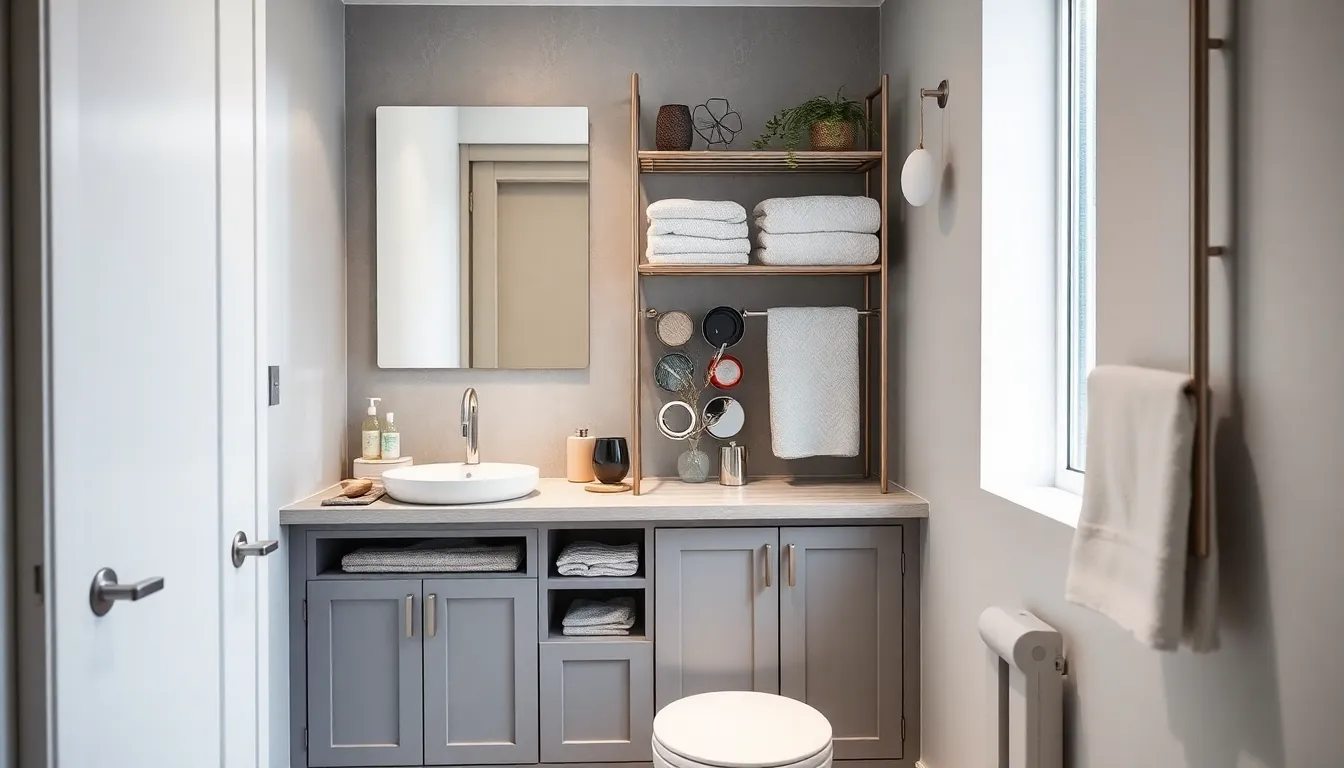
We’re turning our attention to the bathroom, where strategic storage answers can maximize every inch of available space while maintaining functionality and style.
Use Tension Rods for Additional Hanging Space
Tension rods create instant hanging storage without drilling holes or permanent installations. Install these versatile tools inside shower enclosures, above sinks, or between walls to hang towels, robes, and shower caddies effortlessly. We recommend positioning multiple rods at different heights to accommodate various items and keep clutter off floors and counters.
Shower areas benefit tremendously from tension rod installations since they provide quick access to frequently used items like loofahs and bath products. Above-sink placement works perfectly for hand towels and washcloths, while wall-to-wall installations can support heavier items like bathrobes. This approach makes our bathroom feel more open and manageable by utilizing previously unused vertical space.
Install Corner Shelving Units in Unused Areas
Corner shelving units transform wasted angular spaces into functional storage areas for toiletries, cleaning supplies, and decorative items. These modular systems typically require minimal installation effort and work well for both renters and homeowners seeking flexible storage answers. We can position corner shelves at various heights to accommodate different sized products and create visual interest.
Modular corner units adapt easily to our exact bathroom layout and storage needs. Narrow spaces beside showers or above toilets become valuable real estate when we add wall-mounted shelves that extend vertically. These installations maximize our storage capacity while maintaining the bathroom’s clean aesthetic and ensuring easy access to daily essentials.
Choose Vanities With Built-In Storage Compartments
Vanities with multiple drawers, open shelves, and deep cabinets provide discreet organization for cosmetics, grooming products, and cleaning supplies. Modern designs now include slim profiles that fit tight spaces while still offering ample storage capacity for all our bathroom necessities. We should prioritize vanities with compartmentalized storage to keep different product categories organized and easily accessible.
Built-in storage compartments eliminate the need for additional organizers while creating a streamlined appearance in our tiny bathroom. Deep cabinets accommodate larger items like hair dryers and styling tools, while shallow drawers work perfectly for makeup and small accessories. Smart vanity selection becomes the foundation of our bathroom storage strategy, combining form and function in one essential piece.
Establish Separate Zones Within Open Floor Plans
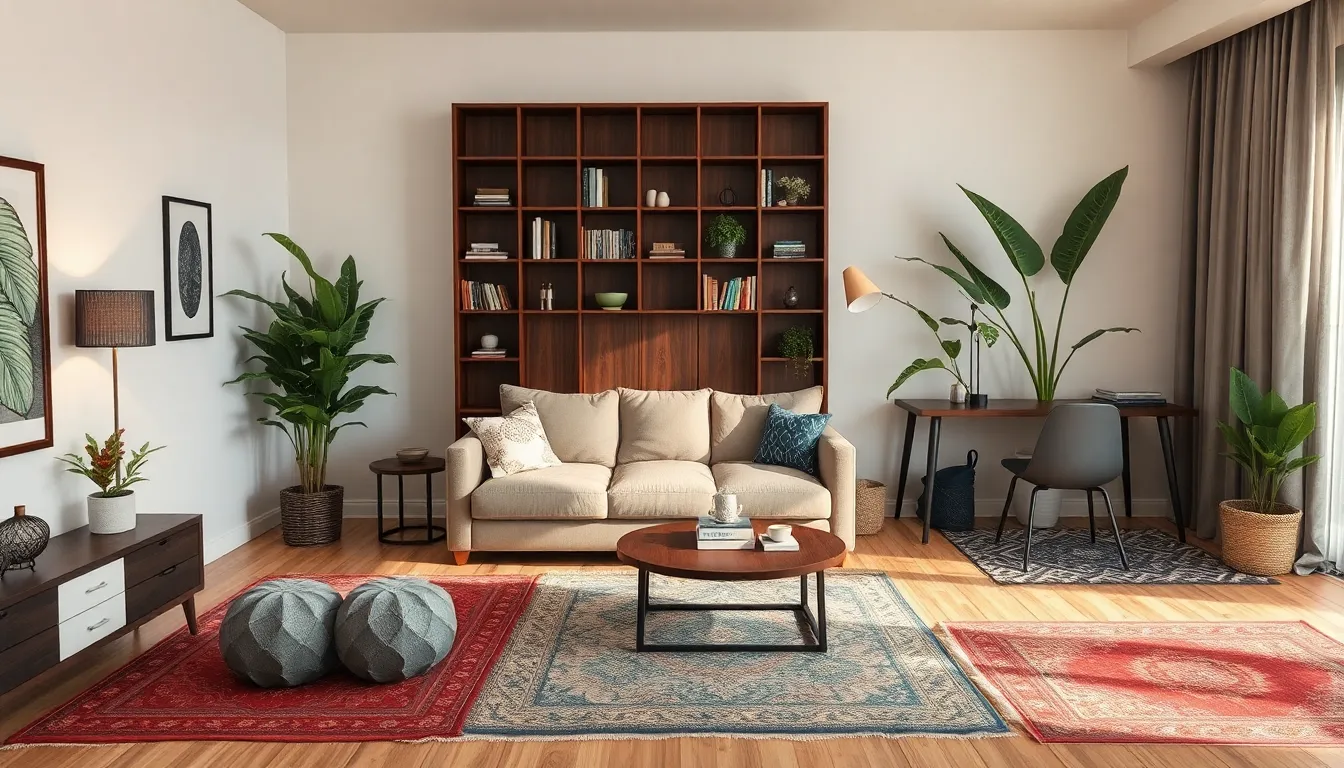
We’ve covered vertical storage and multi-functional furniture answers, so let’s explore how to create distinct living areas within your open floor plan apartment. Establishing separate zones transforms a single room into multiple functional spaces without sacrificing the airy feel of your tiny home.
Use Room Dividers to Create Privacy
Room dividers offer the perfect solution for creating privacy between sleeping areas and living spaces in studio apartments. We recommend folding screens that can be adjusted throughout the day, allowing you to open up the space when entertaining and close it off for restful sleep. Curtains mounted on ceiling tracks provide another flexible option that won’t consume valuable floor space while offering complete visual separation.
Bookshelf dividers serve dual purposes by providing storage while defining separate zones. These tall, narrow units create natural boundaries between your bed and sofa areas while displaying books, plants, and decorative items. Hanging room dividers made from bamboo or fabric panels add texture and visual interest while maintaining the apartment’s flow.
Position Furniture to Define Living Areas
Strategic furniture placement creates natural boundaries that define different living areas without walls or barriers. We suggest positioning your sofa perpendicular to the wall to create a cozy seating nook that separates the living area from other zones. Placing a console table behind the sofa establishes a clear division while providing additional surface space for lamps or decor.
Desks positioned at an angle can separate workspace areas from relaxation zones effectively. This arrangement creates a dedicated office corner while maintaining sight lines throughout the apartment. Tall plants or floor lamps placed strategically between furniture pieces reinforce these visual boundaries while adding height and dimension to your space.
Add Area Rugs to Visually Separate Spaces
Area rugs provide an affordable and versatile method for visually dividing spaces within open floor plans. We recommend using different rug patterns or colors to distinguish between your sleeping area, living space, and dining zone. A plush rug under your bed creates a cozy bedroom feel, while a durable flat weave rug defines the kitchen or dining area.
Layering smaller rugs creates interesting visual zones that guide foot traffic through your apartment. Round rugs work particularly well for defining conversation areas around seating arrangements, while rectangular rugs anchor dining tables and create clear pathways. These textile boundaries add warmth and texture while helping your eyes recognize distinct functional areas within the single room.
Implement Clever Bedroom Storage Solutions

Bedrooms in tiny apartments require innovative storage approaches that maximize every available inch. We’ll explore smart answers that transform overlooked spaces into valuable storage real estate.
Use Under-Bed Storage Containers and Drawers
Under-bed space represents one of the most valuable storage opportunities in small bedrooms. Rolling storage bins, vacuum-sealed bags, and built-in drawers can accommodate bedding, clothing, and off-season items efficiently. We recommend investing in containers with wheels for easy access and organization.
Beds without existing drawers can benefit from bed risers, which increase under-bed clearance for larger storage containers. This simple modification creates additional vertical space for storing bulky items like winter coats, extra blankets, or holiday decorations. Vacuum-sealed bags work particularly well for compressing seasonal clothing and linens.
Install Bedside Wall Sconces to Free Up Nightstand Space
Wall-mounted bedside lights eliminate the need for bulky table lamps on nightstands. This approach frees up valuable surface area for essential items like phones, books, or glasses. Even the smallest nightstands remain uncluttered when lighting fixtures move to walls.
Bedside sconces contribute to a more open and organized bedroom atmosphere. We suggest choosing adjustable models that provide both ambient and task lighting options. This flexibility allows you to customize brightness levels for reading or relaxation without sacrificing precious nightstand real estate.
Choose Headboards With Built-In Shelving
Headboards equipped with shelves or compartments provide additional storage for books, electronics, and personal items. This design feature reduces reliance on other furniture pieces while keeping necessities within arm’s reach. Built-in storage headboards maximize vertical space without consuming floor area.
We recommend selecting headboards with a combination of open shelving and closed compartments. Open shelves display decorative items and frequently used books, while closed storage conceals clutter like charging cables and medications. This dual approach maintains both functionality and visual appeal in tiny apartment bedrooms.
Optimize Natural Light and Create Visual Space

Natural light transforms tiny apartments into bright, airy spaces that feel significantly larger than their actual square footage. We’ll show you how to maximize every ray of sunlight while creating visual tricks that expand your space.
Hang Mirrors Strategically to Reflect Light
Mirrors multiply available light by reflecting and amplifying sunlight throughout your tiny apartment. Position large mirrors directly opposite windows to capture and distribute natural light across the room. We recommend placing mirrors near existing light sources like table lamps or overhead fixtures to create a brighter atmosphere.
Wall mounted mirrors work best when positioned at eye level or slightly higher to reflect light toward the ceiling rather than the floor. Corner placement helps bounce light around multiple angles, creating depth and dimension in cramped quarters. Choose mirrors with thin frames or frameless designs to maintain clean lines and avoid visual clutter.
Strategic placement techniques include positioning mirrors perpendicular to windows rather than parallel to maximize light reflection. Mirrored furniture pieces like coffee tables or wardrobe doors serve dual purposes by providing functionality while expanding visual space through light multiplication.
Choose Light-Colored Paint and Decor
Light hues reflect natural light more effectively than dark colors, making rooms appear airier and more spacious. We suggest using whites, soft neutrals, and pale pastels on walls and ceilings to blur boundaries and create seamless transitions between surfaces. Light colored paint helps rooms feel open by reflecting rather than absorbing available sunlight.
Cohesive color schemes reduce visual clutter while maintaining style throughout your tiny apartment. Choose 2-3 light colors maximum and repeat them across furniture, textiles, and decorative accessories. Soft grays, warm whites, and gentle beiges work particularly well because they complement natural light without overwhelming small spaces.
Accent pieces in light tones include throw pillows, artwork, and storage containers that reinforce your bright color palette. Light colored furniture reflects more light than dark pieces, contributing to an overall sense of openness and spaciousness in your compact living area.
Use Sheer Curtains to Maintain Privacy
Sheer curtains filter natural light while providing necessary privacy without blocking precious sunlight from entering your tiny apartment. Choose panels in colors that closely match your wall paint to maintain visual continuity and avoid breaking up the space with contrasting elements. Sheer fabrics allow approximately 70-80% of natural light to pass through while softening harsh direct sunlight.
Flexible room division becomes possible with ceiling mounted sheer curtains that can separate sleeping areas from living spaces without permanent construction. We recommend installing curtain tracks that allow panels to slide easily for quick transitions between open and divided layouts. Sheer dividers maintain the sense of openness while creating distinct zones within your compact floor plan.
Privacy answers include layering sheer curtains with light colored blinds or shades for adjustable coverage throughout the day. Morning light filters beautifully through sheers, while evening privacy increases with additional window treatments. Choose curtains slightly wider than your windows to maximize light entry when panels are pulled to the sides.
Embrace Minimalist Decorating Principles
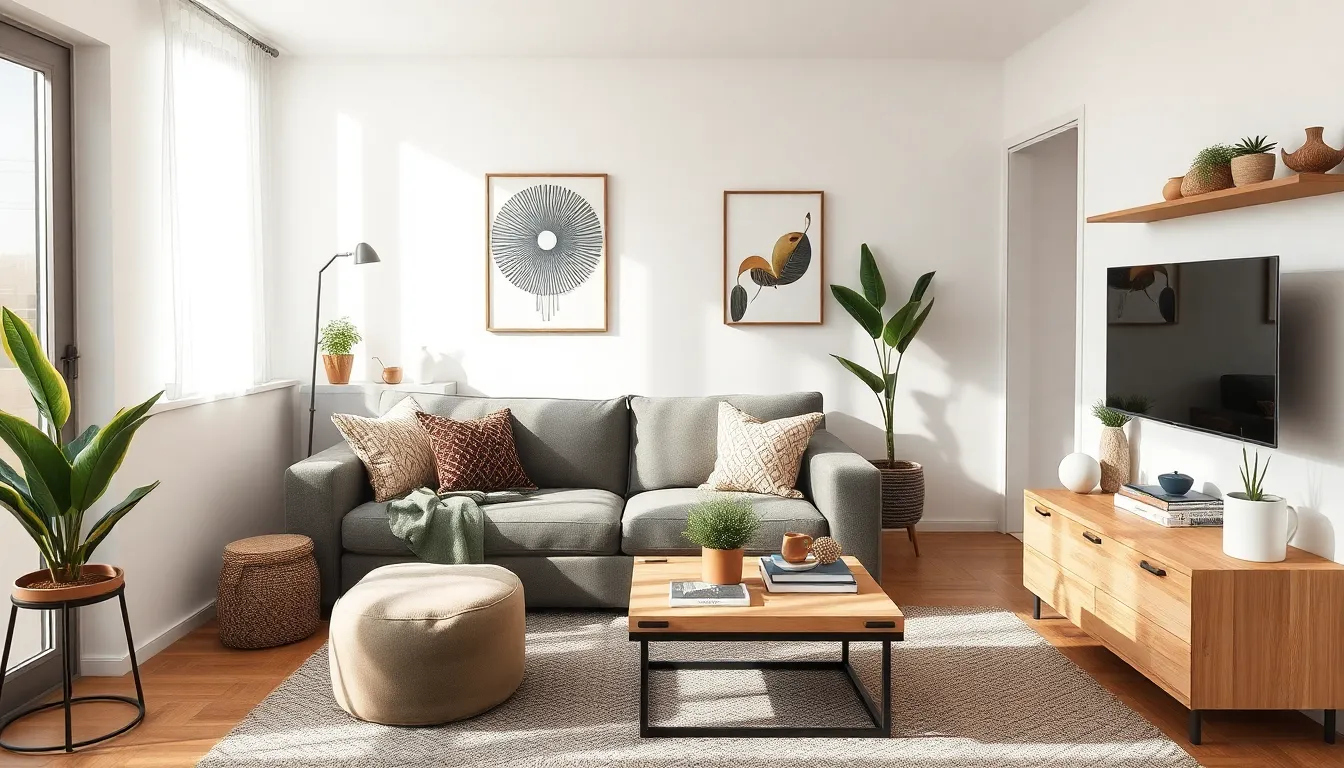
Minimalist design transforms tiny apartments by focusing on simplicity and clean lines that naturally make rooms feel larger. We’ve found that this approach creates open space while avoiding clutter that overwhelms small areas.
Select Multi-Purpose Decorative Items
Sofa beds serve dual purposes by providing comfortable seating during the day and converting to guest accommodations at night. We recommend choosing pieces that seamlessly blend functionality with style, allowing your living room to transform without sacrificing design appeal.
Storage ottomans offer hidden compartments while doubling as extra seating or coffee table surfaces. Murphy beds fold into walls or cabinets, preserving floor space while maintaining a tidy appearance throughout the day.
Coffee tables with built-in storage maximize functionality by housing books, remotes, and decorative items within easy reach. Modular furniture pieces adapt to changing needs, supporting a flexible living environment that evolves with your lifestyle.
Limit Color Palettes for Cohesive Design
Light and neutral tones like white, beige, and soft gray reflect more light while making rooms appear significantly larger. Gallery white walls create an open, airy effect that’s particularly effective in Scandinavian-inspired layouts.
Strategic accent colors can be introduced sparingly through textiles, artwork, or plants without disrupting visual continuity. We suggest using room-warming accents like metal and leather to add depth without overwhelming the space.
Restricted color schemes help blur architectural boundaries and enhance the perception of spaciousness throughout your apartment. This approach creates harmony between different areas while maintaining a cohesive design flow.
Choose Quality Over Quantity for Furnishings
Well-designed furniture pieces like double-duty sofas or expandable tables provide greater utility while minimizing the need for excess items. Investing in durable, versatile furnishings ensures longevity and better use of your limited square footage.
Wall-mounted shelves optimize vertical space while keeping floors clear and visually uncluttered. Built-in storage answers further enhance organization without adding bulk to your living areas.
High-quality materials withstand daily use in compact spaces where every piece works harder than in larger homes. We prioritize thoughtful furniture selection where each item serves multiple purposes and contributes to the overall aesthetic.
Conclusion
We’ve shown you that tiny apartments don’t have to mean compromising on comfort or style. With the right approach these small spaces can become incredibly functional and beautiful homes that reflect your personality.
The key lies in thinking creatively about every square inch. From vertical storage answers to multi-functional furniture each strategy we’ve shared helps you make the most of your limited space while maintaining the lifestyle you want.
Remember that living small doesn’t mean living without the things you love. It’s about being intentional with your choices and finding clever ways to incorporate everything you need into a compact footprint.
Your tiny apartment has unlimited potential waiting to be unlocked. Start implementing these ideas one room at a time and you’ll be amazed at how spacious and organized your small space can feel.
Frequently Asked Questions
How can I maximize storage in a tiny apartment?
Use vertical wall space with floating shelves, under-bed storage containers, and over-door organizers. Install multi-functional furniture like ottoman storage benches and headboards with built-in shelving. In the kitchen, add magnetic strips for utensils and pull-out pantry drawers. These solutions help you utilize every inch while keeping your space organized and clutter-free.
What furniture works best in small living spaces?
Choose multi-purpose pieces like sofa beds, expandable dining tables, and storage ottomans. Fold-down desks and tables save space when not in use. Select furniture that serves dual functions to maximize efficiency. Quality pieces with clean lines work better than multiple smaller items, helping create a more spacious feel.
How do I create separate areas in a studio apartment?
Use room dividers like folding screens, ceiling-mounted curtains, or bookshelf units to define spaces. Position furniture strategically to create natural boundaries between sleeping and living areas. Area rugs with different patterns and colors help visually separate functional zones while maintaining an open, airy atmosphere.
What are the best lighting strategies for tiny apartments?
Maximize natural light by hanging mirrors opposite windows to reflect sunlight throughout the space. Use light-colored paint and decor to enhance brightness. Install wall-mounted bedside sconces to free up surface space. Choose sheer curtains that filter light while maintaining privacy, making rooms feel larger and more open.
How can I organize a small kitchen efficiently?
Install wall-mounted magnetic strips for knives and utensils, and add pull-out pantry drawers for narrow spaces. Use under-cabinet hooks and racks on cabinet doors for additional storage. These solutions keep countertops clear while ensuring easy access to cooking essentials, creating a functional and clutter-free culinary space.
What colors and decor work best in small spaces?
Stick to light and neutral color palettes to enhance spaciousness and create visual flow. Embrace minimalist principles with clean lines and simple designs. Choose quality over quantity in decorative items, selecting pieces that serve both functional and aesthetic purposes. This approach makes rooms feel larger and less cluttered.

